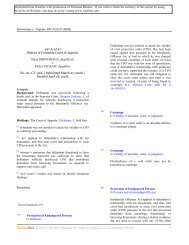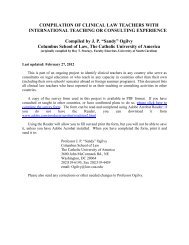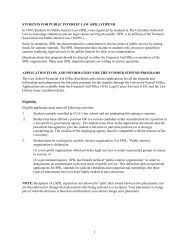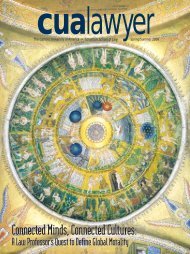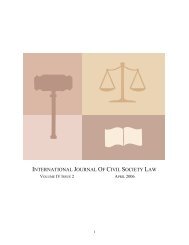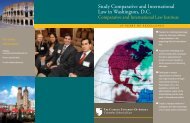CUA Cover Winter 2004 final (Page 2) - Columbus School of Law
CUA Cover Winter 2004 final (Page 2) - Columbus School of Law
CUA Cover Winter 2004 final (Page 2) - Columbus School of Law
- No tags were found...
Create successful ePaper yourself
Turn your PDF publications into a flip-book with our unique Google optimized e-Paper software.
M Y T A K Ethe tragedy and perhaps horror thataccompanies the recognition <strong>of</strong> whatabortion truly is. Many pro-choice advocatesare now opting for one version oranother <strong>of</strong> the latter vantage point — anhonest recognition <strong>of</strong> what an abortiontruly involves.It is recently, and principally in thecontext <strong>of</strong> the national debate over partial-birthabortion, that even worldlysensitivity is being recognized on thepro-life side <strong>of</strong> the ledger. Partial-birthabortions are not only horrible to contemplate,we are beginning to sense thatthey are very likely horribly painful tothe all-but-completely-born child. Researchpublished in the prestigiousBritish medical journal, The Lancet,in 1994, concluded that at some timeduring the second trimester humanfetuses exhibit all the physiological indicationsthat would justify a finding <strong>of</strong>pain in a newborn baby. The articleended with a humane but somewhatstartling suggestion:Just as physicians now provideneonates with adequate analgesia,our findings suggest that thosedealing with the fetus should considermaking similar modificationsto their practice. This applies notjust to diagnostic and therapeuticprocedures on the fetus, but possiblyalso to termination <strong>of</strong> pregnancy,especially by surgical techniquesinvolving dismemberment.The technical language <strong>of</strong> sciencesometimes masks the horror <strong>of</strong> a reality:Fetal children in the womb feel pain(surely one must be alive in order to feelpain), and physicians should consideranaesthetizing them whenever they dismemberthem — alive — in the womb.According to the British MedicalJournal, the neuro-anatomical structuresthat are needed in order to “feel” pain,i.e., the thalamus and the motor nervesthat send a message to the base <strong>of</strong> thebrain, are present in the fetus by theeighth week <strong>of</strong> pregnancy. Some physicians,however, say that the fetus, at theeighth week, would not be capable <strong>of</strong>Thousands <strong>of</strong> anti-abortion demonstratorsprotest outside the Capitol on thethird anniversary <strong>of</strong> the Supreme Court's1973 decision liberalizing accessto legal abortion.experiencing what adult human beingsperceive as pain, because the nerve connectionsbetween the thalamus and thecerebral cortex are not developedenough until the twenty-sixth week <strong>of</strong>pregnancy. Other physicians disagree,and some would place the onset <strong>of</strong> thepain experience as early as that eighthweek, arguing that the cortex is notinvolved in the experience <strong>of</strong> pain.It should be clear by now that the“honest-doubt” principle ought to applyto the issue <strong>of</strong> fetal pain. Even if there isonly an honest doubt as to whether a child inthe womb feels pain (and The Lancet’s findingscertainly place the issue in at leastthe area <strong>of</strong> honest doubt), any trulyhumane and civilized society would andshould resolve that doubt in favor <strong>of</strong> the thesisthat fetuses do feel pain.It is sometimes argued, however,that anesthesia administered to themother during the abortion procedurealso anesthetizes the baby. This argumentcame up prominently during theearly debates over the federal proposalto ban partial-birth abortions, and wasjust as prominently refuted. Dr. Jean A.Wright, Associate Pr<strong>of</strong>essor <strong>of</strong> Pediatricsand Anesthesia at EmoryUniversity’s <strong>School</strong> <strong>of</strong> Medicine, testifiedthat “local anesthetics rarely haveany effect on the fetus,” and went on toexplain:The administration <strong>of</strong> intravenoussedation/anesthesia has minimaleffects on the unborn due to twomechanisms: 1) The mother’s liverclears much <strong>of</strong> the drug, and 2) thedrug must cross from the mother’sblood stream into the placentabefore reaching the fetus.It is difficult to argue that the abortiontechniques currently in use do notinvolve pain — unspeakable pain if thechild indeed feels it. Even pro-abortionadvocates seem to be recognizing it,albeit grudgingly. Pro-choice activistNaomi Wolf wrote in an issue <strong>of</strong> TheNew Republic several years ago, thatfeminism at its best is based onwhat is simply true.…Whileimages <strong>of</strong> violent fetal death workmagnificently for pro-lifers aspolitical polemic, the pictures arenot polemical in themselves: theyare biological facts. We knowthis.…To insist that the truth is inpoor taste is the very height <strong>of</strong>hypocrisy.A self-proclaimed pro-choice physicianin Great Britain, Pr<strong>of</strong>essor VivetteGlover <strong>of</strong> the Queen Charlotte andChelsea Hospital in London, saidrecently:Between seventeen and twenty-six[weeks] it is increasingly possiblethat [the fetus] starts to feel somethingand that abortions done inthat period ought to use anesthesia.Back in 1984, after PresidentReagan had made the statement publiclythat fetuses <strong>of</strong>ten feel pain during abortionprocedures, the reaction from thepro-choice community was, predictably,derisively dismissive. In response to thatderisively dismissive reaction, twenty-sixpr<strong>of</strong>essors and practitioners <strong>of</strong> obstetrics,gynecology, fetal medicine, and30<strong>CUA</strong>LAWYER /<strong>Winter</strong> <strong>2004</strong>




